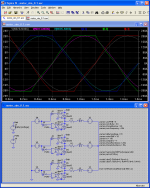Thank you rhitee05, that's an interesting report. Pretty clever of him to illustrate it the way he does. I've read the chapter which discusses what you bring up in your post. I may read more later, it's an extensive report.
Meanwhile, I've expanded my model, and been playing with advance. I can pretty much confirm his findings, that there is a region with more or less constant power with a need of constant increasing advance. With sine wave drive, there is (at least) a region of pure constant power. With the square wave drive, power is slowly decreasing with RPM.
I was able to run my square wave driven model at over nominal speed; 100V EMF, 70V battery voltage and get about 3kW (with 100uH).
Some of my points hasn't been valid. But it's still true that high inductance puts a power limit on the motor. It reaches the constant power region at a lower RPM. I may also try to show that the motor gets less efficient at high RPM with higher inductance because of resistive losses caused by the high RMS currents when using advance.
Meanwhile, I've expanded my model, and been playing with advance. I can pretty much confirm his findings, that there is a region with more or less constant power with a need of constant increasing advance. With sine wave drive, there is (at least) a region of pure constant power. With the square wave drive, power is slowly decreasing with RPM.
I was able to run my square wave driven model at over nominal speed; 100V EMF, 70V battery voltage and get about 3kW (with 100uH).
Some of my points hasn't been valid. But it's still true that high inductance puts a power limit on the motor. It reaches the constant power region at a lower RPM. I may also try to show that the motor gets less efficient at high RPM with higher inductance because of resistive losses caused by the high RMS currents when using advance.




